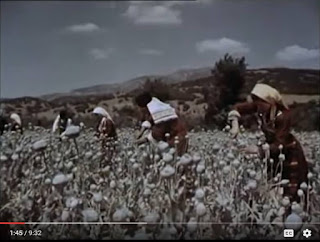The artefact turns out to be from Urartu and is forehead part of the horse head gear. It is currently kept in Karlsruhe, Badisches Landesmuseum.
It was dated to c. 800BC
Urartu is a geographical region commonly used as the exonym for the Iron Age kingdom also known by the modern rendition of its endonym, the Kingdom of Van, centered around Lake Van in the historic Armenian Highlands (present-day eastern Anatolia).
The symbols depicted on this artefacts are very interesting indeed.
The "god", I presume it's a god, is riding on a bull. He is standing in the middle of (wearing) a flying winged disc, usually symbol for the sun and he has what looks like sun disc on his crown. And the whole metal thingy is shaped like a sun with rays pointing upward...
But he couldn't be a sun god.
Because there is only one god in Urartian pantheon which rides on a bull: Theispas the thunder god. He is basically the same god as the Hurian Teshub and Luwian Tarhunz...
And all these gods "ride on a bull" and cary a trident (symbol of lightning)...
And so does the guy on the above artefact. He rides on a bull and holds a trident in each hand...
Or does he?
Here is the close up of one of the "tridents":
To me this looks very very vey much like this: opium poppies...
But why would a storm god cary opium poppies?
Have a look at this:
The planting of poppies throughout the poppy growing regions of the Balkans, Asia Minor and Middle East takes place in the autumn, from September to December, depending on the locality...
If the plant survives the winter, it requires ample rain in between March and May.
The rainfall pattern in the Anatolian (Armenian) plateau
Here is the average precipitation in eastern Anatolian plateau, lake Van region, the land of Urartians and Hurians. The rain peaks in April.
In the rest of the Anatolian plateau, the land of the Hittites, the rain peaks in May.
Which is why, I believe, Urartian Theispas, Hurrian Teshub, Luwian Tarhunz...All ride on a bull...
But Taurus doesn't only bring rain to Anatolian (Armenian) plateau. It also brings summer.
As you can see in the above precipitation tables, the May-June is when the rains stop and the hot weather starts. Exactly what opium poppies need to flower and ripen:
I already wrote in my posts "Ram and bull" and "Symbols of the seasons", about the bull being the symbol of the summer.As you can see in the above precipitation tables, the May-June is when the rains stop and the hot weather starts. Exactly what opium poppies need to flower and ripen:
The summer starts at the beginning of May, during wild Eurasian cattle calving season and ends at the beginning of August, during wild Eurasian cattle mating season...
Bull is the true symbol of summer...
And summer is the main opium poppy harvesting season:
In Afghanistan, the opium poppy harvest season starts in late April early May...
In Iraq, the opium poppy harvest season starts in late April early May...
In Iran, the opium poppy harvest season starts in later April early May...
These are stills from an amazing Macedonian documentary from 1955 called Rhythm And Sound. Showing poppy harvesting.
You can find video here: part 1, part 2
So here are some questions:
1. Is the guy on the Urartian artefact the thunder god? I presume he is a god and not a stoned acrobat...
2. Is he carrying poppies to announce the beginning of the opium harvest season? Sort of: The pusher's here!!! The Thunder dude!!! It's party time!!!
3. Did the trident, the symbol of thunder gods, develop from poppies?
What do you think?
Great source of information about the cultivation of poppies in the Balkans, Asia Minor and Middle East is this article entitled "Some Observations on the Cultivation of Opium Poppy (Papaver somniferum L.) for Its Latex" by A. D. Krikorian and Myron C. Ledbetter
What is very interesting as well is that apparently, opium poppies were "...most likely first cultivated for human use in Asia Minor or in the Balkans..." according to "Troubling Fields: The Opium Poppy in Egypt" by Joseph J. Hobbs
So the link between the poppies harvest, which starts right after the Thunder gods bring thunderstorms in Taurus, during the calving of the wild cattle, was very strong in the area from the beginning...















In Flanders the local name for poppies (the red ones, not the opium species) is Donderblomme, literally thunderflower. (In Wallonia it's called tonnoire). The will close when rain/thunder comes. An old ritual was to gather red poppies in summer and make bouquets of them. These bouquets then got blessings from a priest. When a thunderstorm approached, they would burn the poppies on the altar of the church to ward of the damaging thunderstorm. (Beginnen donderwolken op te doemen, stook dan vlug uw donderbloemen = When clouds with thunder approach, burn then your poppies fast)
ReplyDeleteSo poppies assiociated with thundergods doesn't sound like a strange idea to me.
Thanks very much for this info Sarah. This is very very interesting...
DeleteAlso from West-Flanders, I still know the stories of my grandmother who called this flower sleeping ball (slaapbollen) when She Was Young they used to put this Poppy into the last bottle of milk, or they boiled the milk with the Poppy?of the little children before they went to sleep. I don't know exactly anymore. They also filled pillow's with poppy's for People who couldn't Sleep very well. What i want to say is that there was not a great taboo over it and btw they grow everywhere overhere, there even used to be a law that you had to get rid of them now this law is gone due to ww1 tourist promotion...
ReplyDelete